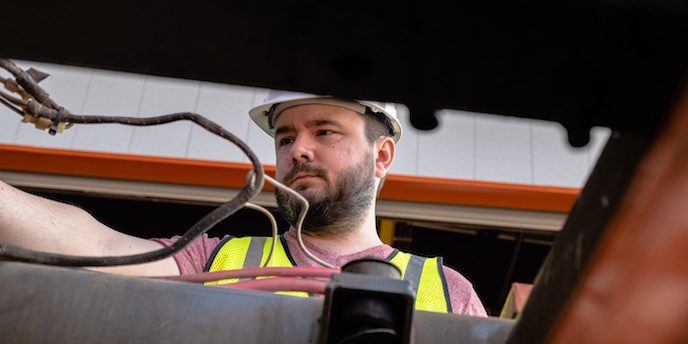

Over the last couple years, markets have seesawed to the extent that even roller coaster enthusiasts are a bit queasy. From great swings in consumer demand, to staffing challenges, to supply chain delays, to inflation, there’s no shortage of issues that businesses, including the equipment rental industry, need to consider as they make everyday and long-term decisions.
And if you’re working in the construction equipment rental industry, there’s no denying it’s tough. But that’s not to say it isn’t insurmountable. There is in fact much to be confident about.
First, the construction rental industry is healthy, and many outfits are thriving.
Consider this May 2022 survey from the American Rental Association, whose results were published by AC Business Media. Equipment rental revenue in the US, including construction and general tool, is projected to increase by 11.1% in 2022. Construction is expected to grow by 13% and general tools by 7%.
“Despite several headwinds, we see good growth through 2023, then more moderate growth in the following years” says Tom Doyle, Vice President of Program Development for the ARA. Rental has experienced significant growth and generally does well in uncertain times.
Construction is expected to grow by 13% and general tools by 7%.
What’s causing the headwinds?
Since the Spring of 2018 (except for a short time in 2020 when much of the nation was shut down), there have been more job openings than people looking for work in the US. Industries across the board are suffering from the lack of workers.
According to a survey published by AC Business Media, there is a growing concern about finding labor in the equipment rental industry. The survey measured concern after the first quarter of 2022 at 14% higher than in 2021.
The labor issues are forcing equipment rental businesses to make do with less and encouraging them to focus on employee retention.
Even though the forecast is positive for the equipment rental industry, 30% of respondents to the ARA survey feel that the overall situation for equipment rental is trending downward.
The reason behind the pessimism is fatigue, much of it coming from the challenges of dealing with a broken supply chain.
Doyle, who has been with ARA for four years and interacted with the organization for 15 years while at his previous job, described the disruption of the supply chain as severe. Members of ARA echo the sentiment. “ARA members tell me they haven’t seen the supply chain in worst shape.” Demand is outpacing supply.
The new and dysfunctional supply chain is certainly having some impact on Big L Rentals and Sales. Founded in 1996, the small independent (900 pieces of gear) serves Southwest Kansas. These days they need to place fleet orders 18 months in advance. In the past, they placed orders 3-6 months in advance.
The ARA survey found another headwind disrupting the equipment rental market: 91% of members must address rising input costs.
“There’s no category where we buy that has not seen at least a 10% rise in costs,” says Ben Blood of Big L Rentals and Sales. Among the largest increases is fuel which has risen by 70%. He expects the industry to raise prices in reaction. “Overall, there’s been a slow reaction to rising prices as rates are not significantly higher despite significantly higher costs.”
Improved efficiency is one way the rental equipment industry can meet its various challenges. According to the survey, 51% of companies are working to increase business efficiencies. These days improving business efficiency starts with technology, particularly since workforce availability is limited.
A separate ARA survey designed to help members determine which software features industry members consider valuable and separated between small and medium-sized rental companies, was instructive.
Respondents in both categories were nearly unanimous in their view that quote contract management, analytics dashboards, and business metrics were either useful or very useful. All three technologies can assist equipment rental businesses to be more efficient.
These days improving business efficiency starts with technology, particularly since workforce availability is limited.
Along these same lines are telematics and ERP (Enterprise Resource Planning), which both Blood and Doyle noted. These technologies can help rental businesses during the current busy times and the eventual and inevitable slowdown ahead.
Although GPS and telematics appeared on the scene about a decade ago, they have become a useful tool only recently. Telematics can help equipment rental businesses in multiple ways, including improving the customer experience.
“Technology and innovation, such as telematics, have and will positively impact rental. They are bringing efficiencies to rental companies and will help customers manage their equipment solutions better, track the location of equipment, and determine the condition of equipment,” Doyle says.

Telematics alerts about equipment maintenance and repair needs can lead to extending the productive life of tools. They also help manage inventory giving rental equipment companies visibility into their fleet, and in no small way, contributing to the industry-wide push to eliminate downtime. By having this information at their fingertips, salespeople can be more effective as they know exactly what equipment is available.
“Every process has changed because of the implementation of telematics,” says Blood. One example he cites as a problem solved with telematics is mishandled paperwork. “If something is not being tracked the right way – which happens when you have many pieces, it impacts billing.”
ERP, a type of software used to manage daily business needs, can increase efficiencies on the back end. An ERP can help with planning, budgeting, and predicting enable businesses to do more with less labor.
The demand for rental equipment remains strong. However, the overall economy has some soft spots and will eventually slow – it’s part of the business cycle.
The equipment rental industry will follow the overall economy. Nonetheless, technology that can serve as both an enabler and disruptor and lead to increased efficiencies can minimize the impact of the ups and downs in the economy. With the move toward specialization, the labor shortage, and rentals enabling businesses to lower customer costs and increase efficiencies, the equipment rental industry is poised to ride out the market fluctuations on the horizon.
Stay in the loop on the latest in data, tech and strategy. Sign up today and receive three insightful reads once a month.
Never miss an insight. We’ll email you when new articles are published on this topic.